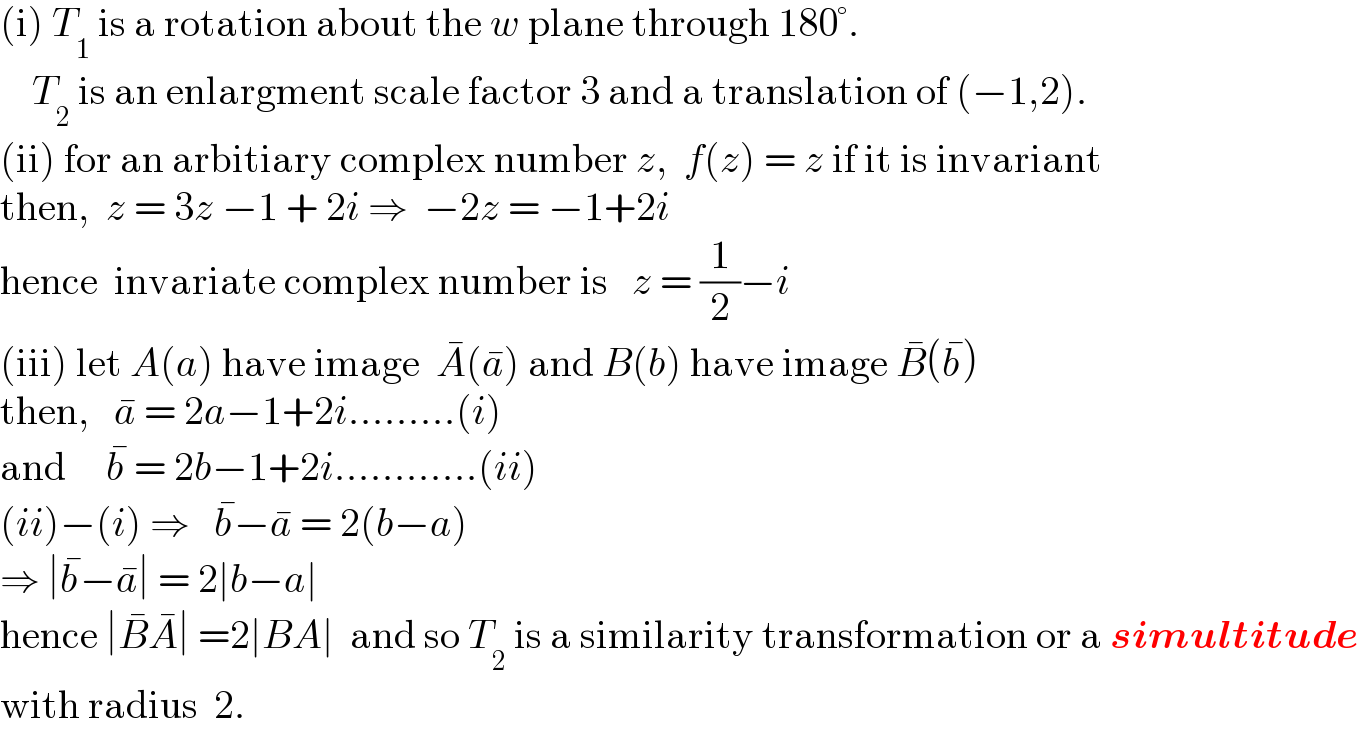Question Number 138765 by 676597498 last updated on 18/Apr/21

Commented by 676597498 last updated on 18/Apr/21

$${please}\:{help} \\ $$
Answered by physicstutes last updated on 18/Apr/21

$$\left(\mathrm{i}\right)\:{T}_{\mathrm{1}} \:\mathrm{is}\:\mathrm{a}\:\mathrm{rotation}\:\mathrm{about}\:\mathrm{the}\:{w}\:\mathrm{plane}\:\mathrm{through}\:\mathrm{180}°. \\ $$$$\:\:\:\:{T}_{\mathrm{2}} \:\mathrm{is}\:\mathrm{an}\:\mathrm{enlargment}\:\mathrm{scale}\:\mathrm{factor}\:\mathrm{3}\:\mathrm{and}\:\mathrm{a}\:\mathrm{translation}\:\mathrm{of}\:\left(−\mathrm{1},\mathrm{2}\right). \\ $$$$\left(\mathrm{ii}\right)\:\mathrm{for}\:\mathrm{an}\:\mathrm{arbitiary}\:\mathrm{complex}\:\mathrm{number}\:{z},\:\:{f}\left({z}\right)\:=\:{z}\:\mathrm{if}\:\mathrm{it}\:\mathrm{is}\:\mathrm{invariant} \\ $$$$\mathrm{then},\:\:{z}\:=\:\mathrm{3}{z}\:−\mathrm{1}\:+\:\mathrm{2}{i}\:\Rightarrow\:\:−\mathrm{2}{z}\:=\:−\mathrm{1}+\mathrm{2}{i} \\ $$$$\mathrm{hence}\:\:\mathrm{invariate}\:\mathrm{complex}\:\mathrm{number}\:\mathrm{is}\:\:\:{z}\:=\:\frac{\mathrm{1}}{\mathrm{2}}−{i} \\ $$$$\left(\mathrm{iii}\right)\:\mathrm{let}\:{A}\left({a}\right)\:\mathrm{have}\:\mathrm{image}\:\:\bar {{A}}\left(\bar {{a}}\right)\:\mathrm{and}\:{B}\left({b}\right)\:\mathrm{have}\:\mathrm{image}\:\bar {{B}}\left(\bar {{b}}\right) \\ $$$$\mathrm{then},\:\:\:\bar {{a}}\:=\:\mathrm{2}{a}−\mathrm{1}+\mathrm{2}{i}………\left({i}\right) \\ $$$$\mathrm{and}\:\:\:\:\:\bar {{b}}\:=\:\mathrm{2}{b}−\mathrm{1}+\mathrm{2}{i}…………\left({ii}\right) \\ $$$$\left({ii}\right)−\left({i}\right)\:\Rightarrow\:\:\:\bar {{b}}−\bar {{a}}\:=\:\mathrm{2}\left({b}−{a}\right) \\ $$$$\Rightarrow\:\mid\bar {{b}}−\bar {{a}}\mid\:=\:\mathrm{2}\mid{b}−{a}\mid \\ $$$$\mathrm{hence}\:\mid\bar {{B}}\bar {{A}}\mid\:=\mathrm{2}\mid{BA}\mid\:\:\mathrm{and}\:\mathrm{so}\:{T}_{\mathrm{2}} \:\mathrm{is}\:\mathrm{a}\:\mathrm{similarity}\:\mathrm{transformation}\:\mathrm{or}\:\mathrm{a}\:\boldsymbol{{simultitude}} \\ $$$$\mathrm{with}\:\mathrm{radius}\:\:\mathrm{2}. \\ $$
Answered by TheSupreme last updated on 18/Apr/21
![z={Re(z),Im(z)} w=−{Re(z),−Im(z)}= [((−1),0),(0,1) ]{z}^T T_1 is a simmetry on real−axis w=3z−1+2i= [(3,0),(0,3) ]{z}^T + [((−1)),((2i)) ] T_2 is a scale with center (((−1)/3),((2i)/3))>](https://www.tinkutara.com/question/Q138808.png)
$${z}=\left\{{Re}\left({z}\right),{Im}\left({z}\right)\right\} \\ $$$${w}=−\left\{{Re}\left({z}\right),−{Im}\left({z}\right)\right\}=\begin{bmatrix}{−\mathrm{1}}&{\mathrm{0}}\\{\mathrm{0}}&{\mathrm{1}}\end{bmatrix}\left\{{z}\right\}^{{T}} \\ $$$${T}_{\mathrm{1}} \:{is}\:{a}\:{simmetry}\:{on}\:{real}−{axis} \\ $$$${w}=\mathrm{3}{z}−\mathrm{1}+\mathrm{2}{i}=\begin{bmatrix}{\mathrm{3}}&{\mathrm{0}}\\{\mathrm{0}}&{\mathrm{3}}\end{bmatrix}\left\{{z}\right\}^{{T}} +\begin{bmatrix}{−\mathrm{1}}\\{\mathrm{2}{i}}\end{bmatrix} \\ $$$${T}_{\mathrm{2}} \:{is}\:{a}\:{scale}\:{with}\:{center}\:\left(\frac{−\mathrm{1}}{\mathrm{3}},\frac{\mathrm{2}{i}}{\mathrm{3}}\right)> \\ $$
